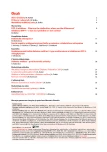Inhibítory DPP-4 – v čom sú si podobné a v čom sa líšia?
Autoři:
Matthias Blüher
Působiště autorů:
Faculty of Medicine, University of Leipzig, Leipzig, Germany and University Hospital Leipzig, Department of Internal Medicine III - Department of endocrinology and nephrology, Leipzig, Germany
Vyšlo v časopise:
Forum Diab 2012; 1(1): 8-16
Kategorie:
Hlavná téma
Souhrn
Narastajúca prevalencia diabetu typu 2 a jeho komplikácií na celom svete prináša potrebu efektívnych a bezpečných liečebných stratégií. Dôležitými perorálnymi antidiabetikami pre starostlivosť o pacientov s diabetom typu 2 sa stali inhibítory dipeptidylpeptidázy-4 (DPP-4). Všetky inhibítory DPP-4 pôsobia na inkretínový systém s cieľom znížiť hyperglykémiu, majú podobný bezpečnostný profil, sú dobre znášané, nespôsobujú významné zvýšenie telesnej hmotnosti a majú relatívne nízke riziko hypoglykémie. Medzi štyrmi agensmi, ktoré sú v súčasnosti schválené Americkým úradom pre potraviny a lieky prípadne Európskou agentúrou pre lieky, sitagliptínom, vildagliptínom, saxagliptínom a linagliptínom, sú však klinické rozdiely. Tento článok pojednáva o podobnostiach a rozdieloch v účinnosti, bezpečnosti a znášanlivosti týchto štyroch inhibítorov DPP-4.
Kľúčové slová:
inhibítory DPP-4 – vildagliptín – sitagliptín – saxagliptín – linagliptín – diabetes typu 2 – inkretínový systém – GLP-1
Zdroje
1. Drucker DJ, Nauck MA. The incretin system: glucagon-like peptide-1 receptor agonists and dipeptidyl peptidase-4 inhibitors in type 2 diabetes. Lancet 2006; 368(9548): 1696–1705.
2. Nauck MA. Incretin-based therapies for type 2 diabetes mellitus: properties, functions, and clinical implications. Am J Med 2011; 124(Suppl 1): S3–S18.
3. Holst JJ, Gromada J. Role of incretin hormones in the regulation of insulin secretion in diabetic and nondiabetic humans. Am J Physiol Endocrinol Metab 2004; 287(Suppl 2): E199–E206.
4. Lotfy M, Singh J, Kalász H et al. Medicinal Chemistry and Applications of Incretins and DPP-4 Inhibitors in the Treatment of Type 2 Diabetes Mellitus. Open Med Chem J 2011; 5(Suppl 2): 82–92.
5. Farilla L, Bulotta A, Hirshberg B et al. Glucagon-like peptide 1 inhibits cell apoptosis and improves glucose responsiveness of freshly isolated human islets. Endocrinology 2003; 144(12): 5149–5158.
6. Buteau J, El-Assaad W, Rhodes CJ et al. Glucagon-like peptide-1 prevents beta cell glucolipotoxicity. Diabetologia 2004; 47(5): 806–815.
7. Brubaker PL, Drucker DJ. Minireview: Glucagon-like peptides regulate cell proliferation and apoptosis in the pancreas, gut, and central nervous system. Endocrinology 2004; 145(6): 2653–2659.
8. Karagiannis T, Paschos P, Paletas K et al. Dipeptidyl peptidase-4 inhibitors for treatment of type 2 diabetes mellitus in the clinical setting: systematic review and meta-analysis. BMJ 2012; 344: e1369.
9. Bergman AJ, Cote J, Yi B et al. Effect of renal insufficiency on the pharmacokinetics of sitagliptin, a dipeptidyl peptidase-4 inhibitor. Diabetes Care 2007; 30(7): 1862–1864.
10. Heise T, Graefe-Mody EU, Hüttner S et al. Pharmacokinetics, pharmacodynamics and tolerability of multiple oral doses of linagliptin, a dipeptidyl peptidase-4 inhibitor in male type 2 diabetes patients. Diabetes Obes Metab 2009; 11(8): 786–794.
11. Ahren B, Pacini G, Tura A et al. Improved meal-related insulin processing contributes to the enhancement of B-cell function by the DPP-4 inhibitor vildagliptin in patients with type 2 diabetes. Hormone Metab Res 2007; 39(11): 826–829.
12. Balas B, Baig MR, Watson C et al. The dipeptidyl peptidase IV inhibitor vildagliptin suppresses endogenous glucose production and enhances islet function after single dose administration in type 2 diabetic patients. J Clin Endocrinol Metab 2007; 92 : 12249–12255.
13. Azuma K, Rádiková Z, Mancino J et al. Measurements of islet function and glucose metabolism with the dipeptidyl peptidase 4 inhibitor vildagliptin in patients with type 2 diabetes. J Clin Endocrinol Metab 2008; 93(2): 459–464.
14. Thomas L, Eckhardt M, Langkopf E et al. (R)-8-(3-amino-piperidin-1-yl)-7-but-2-ynyl-3-methyl-1-(4-methyl-quinazoli n-2-ylmethyl)-3,7-dihydro-purine-2,6-dione (BI 1356), a novel xanthine-based dipeptidyl peptidase 4 inhibitor, has a superior potency and longer duration of action compared with other dipeptidyl peptidase-4 inhibitors. J Pharmacol Exp Ther 2008; 325(1): 175–182.
15. Scheen AJ. Pharmacokinetics of dipeptidylpeptidase-4 inhibitors. Diabetes Obes Metab 2010; 12(8): 648–658.
16. Cox ME, Rowell J, Corsino L et al. Dipeptidyl peptidase-4 inhibitors in the management of type 2 diabetes: safety, tolerability, and efficacy. Drug Healthc Patient Saf 2010; 2(1): 7–19.
17. Baetta R, Corsini A. Pharmacology of dipeptidyl peptidase-4 inhibitors: similarities and differences. Drugs 2011; 71(11): 1441–1467.
18. Lukashevich V, Schweizer A, Shao Q et al. Safety and efficacy of vildagliptin versus placebo in patients with type 2 diabetes and moderate or severe renal impairment: a prospective 24-week randomized placebo-controlled trial. Diabetes Obes Metab 2011; 13(10): 947–954.
19. Ito M, Abe M, Okada K, Sasaki H, Maruyama N, Tsuchida M, Higuchi T, Kikuchi F, Soma M. The dipeptidyl peptidase-4 (DPP-4) inhibitor vildagliptin improves glycemic control in type 2 diabetic patients undergoing hemodialysis. Endocr J 2011; 58(11): 979–987.
20. Aroda V et al. Poster Presentation 836. Presented at: 46th Scientific Sessions of the European Association for the Study of Diabetes; September 20–24, 2010; Stockholm, Sweden.
21. Marfella R, Barbieri M, Grella R et al. Effects of vildagliptin twice daily vs. sitagliptin once daily on 24-hour acute glucose fluctuations. J Diabetes Complications 2010; 24(2): 79–83.
22. Krinsley JS. Glycemic variability and mortality in critically ill patients: the impact of diabetes. J Diabetes Sci Technol 2009; 3(6): 1292–1301.
Štítky
Diabetologie Endokrinologie Interní lékařstvíČlánek vyšel v časopise
Forum Diabetologicum

2012 Číslo 1
Nejčtenější v tomto čísle
- Inhibítory DPP-4 – v čom sú si podobné a v čom sa líšia?
- Čo má nasledovať po metformíne?
- Diabetická retinopatia 1
- Diabetes mellitus – prvé historické zmienky
